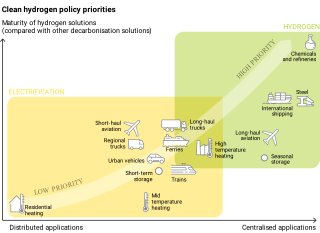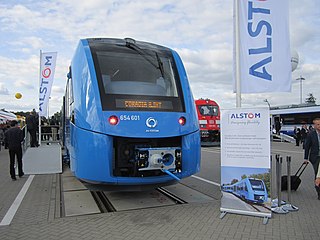
A fuel cell is an electrochemical cell that converts the chemical energy of a fuel and an oxidizing agent into electricity through a pair of redox reactions. Fuel cells are different from most batteries in requiring a continuous source of fuel and oxygen to sustain the chemical reaction, whereas in a battery the chemical energy usually comes from substances that are already present in the battery. Fuel cells can produce electricity continuously for as long as fuel and oxygen are supplied.

A hydrogen vehicle is a vehicle that uses hydrogen to move. Hydrogen vehicles include some road vehicles, rail vehicles, space rockets, forklifts, ships and aircraft. Motive power is generated by converting the chemical energy of hydrogen to mechanical energy, either by reacting hydrogen with oxygen in a fuel cell to power electric motors or, less commonly, by hydrogen internal combustion.

The hydrogen economy is an umbrella term for the roles hydrogen can play alongside low-carbon electricity to reduce emissions of greenhouse gases. The aim is to reduce emissions where cheaper and more energy-efficient clean solutions are not available. In this context, hydrogen economy encompasses the production of hydrogen and the use of hydrogen in ways that contribute to phasing-out fossil fuels and limiting climate change.

A fuel cell vehicle (FCV) or fuel cell electric vehicle (FCEV) is an electric vehicle that uses a fuel cell, sometimes in combination with a small battery or supercapacitor, to power its onboard electric motor. Fuel cells in vehicles generate electricity generally using oxygen from the air and compressed hydrogen. Most fuel cell vehicles are classified as zero-emissions vehicles. As compared with internal combustion vehicles, hydrogen vehicles centralize pollutants at the site of the hydrogen production, where hydrogen is typically derived from reformed natural gas. Transporting and storing hydrogen may also create pollutants. Fuel cells have been used in various kinds of vehicles including forklifts, especially in indoor applications where their clean emissions are important to air quality, and in space applications. Fuel cells are being developed and tested in trucks, buses, boats, ships, motorcycles and bicycles, among other kinds of vehicles.
Energy-Quest was an organization launched in 2005 that sought to educate the public about the risks of an impending energy crisis due to the current worldwide dependence on fossil fuels and the benefits of energy conservation and the use of renewable energy sources. It intended to do so through a series of three record-setting ocean voyages:
- The Earthrace
- The Aurora Expedition
- The Triton Expedition
Direct borohydride fuel cells (DBFCs) are a subcategory of alkaline fuel cells which are directly fed by sodium borohydride or potassium borohydride as a fuel and either air/oxygen or hydrogen peroxide as the oxidant. DBFCs are relatively new types of fuel cells which are currently in the developmental stage and are attractive due to their high operating potential in relation to other type of fuel cells. Recently, DBFCs that rival proton-exchange membrane fuel cells (PEMFCs) in peak power but operating at double the voltage have been reported.
Hydrogen gas is produced by several industrial methods. Nearly all of the world's current supply of hydrogen is created from fossil fuels. Most hydrogen is gray hydrogen made through steam methane reforming. In this process, hydrogen is produced from a chemical reaction between steam and methane, the main component of natural gas. Producing one tonne of hydrogen through this process emits 6.6–9.3 tonnes of carbon dioxide. When carbon capture and storage is used to remove a large fraction of these emissions, the product is known as blue hydrogen.

Metal hydride fuel cells are a subclass of alkaline fuel cells that have been under research and development, as well as scaled up successfully in operating systems. A notable feature is their ability to chemically bond and store hydrogen within the fuel cell itself.
Hydrogen technologies are technologies that relate to the production and use of hydrogen as a part hydrogen economy. Hydrogen technologies are applicable for many uses.

A hydrogen-powered aircraft is an aeroplane that uses hydrogen fuel as a power source. Hydrogen can either be burned in a jet engine or another kind of internal combustion engine, or can be used to power a fuel cell to generate electricity to power an electric propulsor. It cannot be stored in a traditional wet wing, and hydrogen tanks have to be housed in the fuselage or be supported by the wing.

A fuel cell bus is a bus that uses a hydrogen fuel cell as its power source for electrically driven wheels, sometimes augmented in a hybrid fashion with batteries or a supercapacitor. The only emission from the bus is water. Several cities around the world have trialled and tested fuel cell buses, with over 5,600 buses in use worldwide, the majority of which are in China.

In transportation, the original (2003) generic term "hydrail" includes hydrogen trains, zero-emission multiple units, or ZEMUs — generic terms describing rail vehicles, large or small, which use on-board hydrogen fuel as a source of energy to power the traction motors, or the auxiliaries, or both. Hydrail vehicles use the chemical energy of hydrogen for propulsion, either by burning hydrogen in a hydrogen internal combustion engine, or by reacting hydrogen with oxygen in a fuel cell to run electric motors, as the hydrogen fuel cell train. Widespread use of hydrogen for fueling rail transportation is a basic element of the proposed hydrogen economy. The term has been used by research scholars and technicians around the world.
AFC Energy PLC is a developer of hydrogen fuel cell technologies which focus on the displacement of diesel generators in stationary and maritime applications. The technology utilises hydrogen fuel for zero emission electricity generation. The company is based in Cranleigh, Surrey, United Kingdom. It is listed on the London Stock Exchange.

Hi-Gen Power was a London-based developer of projects combining underground coal gasification with carbon capture and storage and alkaline fuel cells. It was established in 2009 to commercialize alkaline fuel cells developed by the fuel cell manufacturer AFC Energy. It is affiliated with B9 Gas.

The principle of a fuel cell was discovered by Christian Friedrich Schönbein in 1838, and the first fuel cell was constructed by Sir William Robert Grove in 1839. The fuel cells made at this time were most similar to today's phosphoric acid fuel cells. Most hydrogen fuel cells today are of the proton exchange membrane (PEM) type. A PEM converts the chemical energy released during the electrochemical reaction of hydrogen and oxygen into electrical energy. The Hydrogen Research, Development, and Demonstration Act of 1990 and Energy Policy Act of 1992 were the first national legislative articles that called for large-scale hydrogen demonstration, development, and research programs. A five-year program was conducted that investigated the production of hydrogen from renewable energy sources and the feasibility of existing natural gas pipelines to carry hydrogen. It also called for the research into hydrogen storage systems for electric vehicles and the development of fuel cells suitable to power an electric motor vehicle.
Intelligent Energy is a fuel cell engineering business focused on the development, manufacture and commercialisation of its proton-exchange membrane fuel cell technologies for a range of markets including automotive, stationary power, materials handling equipment and UAVs. Headquartered in the UK with representation in the US, Japan, South Korea, and China.
Hydrogenics is a developer and manufacturer of hydrogen generation and fuel cell products based on water electrolysis and proton-exchange membrane (PEM) technology. Hydrogenics is divided into two business units: OnSite Generation and Power Systems. Onsite Generation is headquartered in Oevel, Belgium and had 73 full-time employees as of December 2013. Power Systems is based in Mississauga, Ontario, Canada, with a satellite facility in Gladbeck, Germany. It had 62 full-time employees as of December 2013. Hydrogenics maintains operations in Belgium, Canada and Germany with satellite offices in the United States, Indonesia, Malaysia and Russia.

The International Partnership for Hydrogen and Fuel Cells in the Economy (IPHE]) is an inter-governmental cooperative initiative founded in 2003 consisting of 24 countries. The IPHE works with the member countries and leaders in the hydrogen fuel and fuel cell industry in order to further develop and implement those technologies.
Fuel Cell and Hydrogen Energy Association (FCHEA) was formed in November 2010 following the merger of two former associations representing different sectors of the industry, the U.S. Fuel Cell Council and the National Hydrogen Association. FCHEA has more than sixty organizations as members. The Association's history dates back to 1989 through the creation of NHA.
The World Hydrogen Council is a global CEO-led initiative of 132 leading energy, transport, industry, and investment companies that seeks to develop the hydrogen economy. It claims to accelerate investment in the development and commercialization of the hydrogen and fuel cell sectors and encourage stakeholders to increase their backing of hydrogen as part of the future energy mix.











